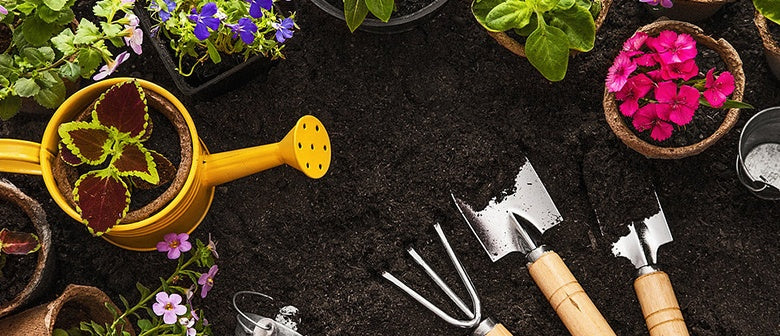With Spring just around the corner, now is the time to start thinking about your garden and the tools you will need for the season ahead. It can be easy to go overboard on the gardening tools, so if you’re looking to downsize your collection to make some space in the shed, or if you’re new to gardening and don’t know where to start, here are the tools that you need in your arsenal this Spring!
Spade
Spades have garden purposes that stretch beyond digging! They can be used in cultivation, terracing, contouring, and aid in such tasks as drainage.
A spade is handy for digging, especially in sandy or loamy (medium textured and easy to cultivate) soil. It is also great if you’re planning on moving larger quantities of bulk material this Spring!
A spade will allow you to dig straight-edged, neat trenches for flower beds and vegetable patches as well as shaping edges on a lawn.
Digging fork
A digging fork’s function is just as its name suggests, for digging. The strong tines of the digging fork are able to penetrate problem soils that a spade can have trouble cutting in to. The digging fork can be used to “dig” up the ground or simply loosen up the area before digging with a spade. Either way, using a digging fork will reduce the strain on your body.
You can use a digging fork for lifting and pitching as well as turning over organic material like compost.
Digging forks are also used to dig up plants with tough or massive root structures. These can be garden plants that you intend to transplant or divide, or patches of pesky weeds. The tines of digging forks can cause less damage to root structures, allowing you to get out more of roots than you can with a spade. For garden plants, this reduces the stress of transplanting. For weeds, this can help you get out all the roots so they don’t return later. When using a digging fork to dig up plants, you can use it in combination with a spade, using the digging fork to loosen up the soil around the plants and roots, then completing the task with a spade.
Secateurs
Before you start, make sure your secateurs are sharp, and more importantly, clean! It’s good practice to rinse your tools after using them as this gets rid of any dirt that may be on the tool, it will also help you stop spreading diseases, fungi, insect eggs and weeds around your garden!
Secateurs have so many uses in the garden which is why they’re a great tool to have in the shed! Generally speaking, secateurs can be used to clean, cut, and trim away branches, weeds, and stems that are unwanted in your garden. Whether you’re harvesting fresh produce or cutting back berry bushes, you’ll want to equip yourself with a set of sturdy secateurs. For a clean cut, snip at the node of the plant (where the branch meets the stem in a Y shape).
3 Tine Cultivator
The 3 Tine Cultivator is a great tool for mixing potting soils or compost. The 3 sharp tines allow you to break any large clumps and obtain a nice, consistent potting soil or compost mixture. It is also great for aerating the soil.
You can also use this 3 prong cultivating tool for incorporating compost into your garden soil or garden beds for soil amending.
It works great as a shallow cultivation tool for scratching the soil surface to remove and prevent the emergence of small nuisance weeds. Just pull the tool along the soil surface to provide a shallow soil disturbance that will kill small weeds and prevent germination of new ones.
In gardens with rows that are narrowly-spaced, this tool is perfect for cultivating between rows in spaces where you may not be able to fit a larger cultivating tool.
5L sprayer
A garden sprayer is a great tool to have in your kit for Spring. Fertilising or applying pesticides can be done with a pressurised sprayer. It is an especially good idea to spray the weeds before they set seed. If your lawn or garden is over-run with weeds, a weed sprayer may be the boost you need to help you win the battle. These sprayers allow you to treat large areas without getting a cramped trigger finger from using a spray bottle.

